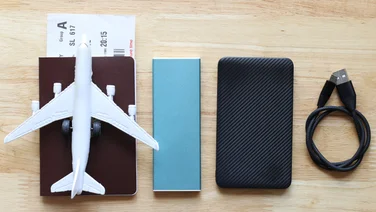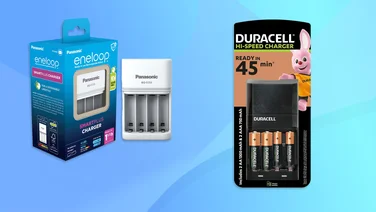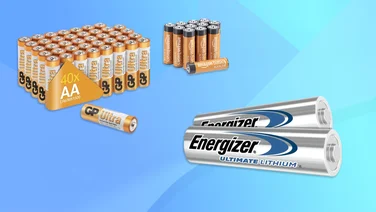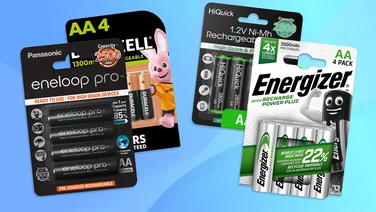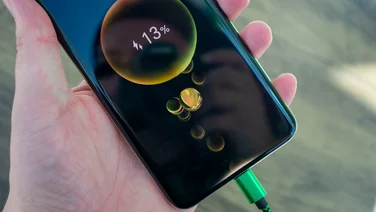To help us provide you with free impartial advice, we may earn a commission if you buy through links on our site. Learn more
- The best power banks you can buy in 2025
- 1. Anker Zolo A1680: Best power bank for most people
- 2. Anker Zolo A1684: Best budget wireless power bank
- 3. Juice Eco Max+: Best budget high-capacity power bank
- 4. Anker MagGo 10K: Best fast MagSafe power bank
- 5. Belkin BoostCharge Pro 10,000mAh: Best power bank for fast wireless charging
- 6. Cuktech 15 Ultra: Best big power bank for laptops and tablets
- How to choose the best power bank or charger for you

With mobile devices constantly getting bigger and more power-hungry, the best power banks are quickly becoming a necessary accessory for long trips out of the house. Whether you’re commuting to work or travelling abroad, having a decent power bank tucked away in your bag amounts to peace of mind that you’re not going to get caught short with no charger in sight.
Our team of experts have tested countless power banks over the years, and have compiled here the very best of them. If you want to get straight to the products, you’ll find a quick look at our top picks just below, with more detail in the mini-reviews a little further down.
For those who are unsure of what to look out for when shopping for a power bank, our buying guide runs through the top criteria to bear in mind.
| Best power banks: At a glance | ||
|---|---|---|
| Best for most people | Anker A1680 Nano (~£30) | |
| Best budget wireless power bank | Anker Zolo A1684 (~£27) | |
| Best fast MagSafe power bank | Anker MagGo 10K | |
| Best high-capacity power bank | Cuktech 15 Ultra (~£90) | |
How we test power banks
We connect power banks through a USB power meter to a range of devices, including Android and iOS smartphones and an Acer Chromebook, to check how much power they output from each of their USB-A and USB-C ports.

We also check their wireless charging capabilities and measure the rate at which they charge from a 65W USB-C charger. Finally, we run a quick charge test to find out how much they can recharge our test smartphone in a 15-minute period.
The best power banks you can buy in 2025
In our latest update to this page we’ve completely overhauled our selection in favour of newer, better value, better performing models. We’ve removed the Anker A1259, MagGo 6.6K and Prime 27,650mAh, the Ugreen Nexode PB560 and PB561, the Juice Eco 2 Charge Magtec and Juice Eco 4 Charge, and the EcoFlow River 2 Max and we’ve replaced them with an even tastier choice.
The Anker Zolo A1680 and A1684 go straight in at positions one and two, the Belkin BoostCharge Pro 10,000mAh, isn’t much further down, and there’s a newcomer to this page: Cuktech. Its awesome Cuktech 15 Ultra, a big, beefy battery pack that’s great for keeping your laptop topped up on the move, and delivers serious value for money.
1. Anker Zolo A1680: Best power bank for most people
Price when reviewed: £30 | Check price at Amazon

- Great for… charging multiple devices and convenience
- Not so great for… wireless charging (there is none), basic display
This is a compact power bank with extras, going beyond the usual USB-A and USB-C charging ports to give you two built-in charging cables: one for USB-C devices and one for older Apple iPads and iPhones with a Lightning connection. With that lot you can actually charge up to four devices at a time, which is impressive for such a low-cost battery pack.
Use one port at a time, and it’s a very speedy portable charger, dishing out up to 18.08W with my Honor smartphone and 29W with a laptop over USB-C. Having the cables built-in also means you won’t get stuck because you haven’t packed your own, and the cables themselves are flexible and sensibly reinforced. There’s even an LCD display on the top surface, which tells you precisely how much charge is remaining.
With a large 10,000mAh capacity, a very reasonable price and so much flexibility it adds up to a potent combination – this is our favourite everyday power bank by quite a distance.
Key specs – Capacity: 10,000mAh; Input: USB-C; Outputs: USB-A (22.5W), USB-C (30W), USB-C captive cable (30W), Lightning captive cable (30W); Dimensions (WDH): 67 x 110 x 25mm; Weight: 200g
2. Anker Zolo A1684: Best budget wireless power bank
Price when reviewed: £27 | Check price at Amazon

- Great for… easy wireless charging with fast wired charging speeds
- Not so great for… fast wireless charging speeds
The Anker Zolo A1684 packs in plenty for a budget power bank, including QI (7.5W) wireless charging, a built-in USB-C cable and speedy 30W wired charging over USB-C. There’s also a handy kickstand and the MagSafe compatible pad will hold iPhones in place securely.
It’s a well-built unit, and the captive USB-C cable plugs neatly into a dummy socket in the unit for storage. What’s more, you can charge the Zolo through the single USB-C port while charging another device through the captive cable and your phone through the wireless pad.
Charging multiple devices simultaneously does reduce charging speeds, but if you stick with one device at a time you’ll get excellent performance. In our tests, the battery supplied 21.15W to our Honor test smartphone and 27.87W to a laptop. This is not just a solid affordable wireless charger, but a strong choice if you need a fast wired top up on the move.
Key specs – Capacity: 5,000mAh; Input: USB-C; Outputs: USB-C (18.5W), Qi wireless (7.5W); Dimensions (WDH): 68 x 106 x 13mm; Weight: 148g
3. Juice Eco Max+: Best budget high-capacity power bank
Price when reviewed: £35 | Check price at Argos

- Great for… massive capacity for multiple gadgets
- Not so great for… underwhelming charging speeds
It’s one of the bigger power banks out there, but the new Juice Eco Max+ makes the size and weight worth your while with a whopping 24,000mAh capacity – 4,000mAh more than the old Juice Max. It features two USB Type-A ports and a USB Type-C port that doubles as an input, and while none of these gives you super-fast charging speeds, 12 to 15W should be enough to keep your gadgets charged over a weekend camping trip or a long commute.
My tests confirmed Juice’s stated charging speeds, with output measured at 11.17W on USB Type-A and a maximum 15.09W over USB Type-C. It won’t handle a laptop but it’s a great option for Nintendo Switch users or anyone travelling with a tablet and a smartphone, as you can charge up to three devices simultaneously from just the one unit. The rounded corners and soft plastic shell make it an easy fit for a bag or backpack, and it’s comparatively cheap as well.
Key specs – Capacity: 24,000mAh; Input: USB-C; Outputs: 2x USB-A (12W), USB-C (15W); Dimensions (WDH): 68 x 140 x 28mm; Weight: 406g
4. Anker MagGo 10K: Best fast MagSafe power bank
Price when reviewed: £90 | Check price at Amazon

- Great for… high charging speeds and a handy kickstand
- Not so great for… anyone on a tight budget
It’s more expensive than the MagGo 6.6K and lacks the ingenious hinged design, but the bigger MagGo 10K is the better power bank in many ways. Its larger 10,000mAh capacity gives you enough juice to charge an iPhone 15 twice and still have some left over, while I found its 20W USB-C port delivered 18.9W in actual use. And you’ve still got a 15W Qi2 charging pad if you don’t want to be bothered with a cable.
A clever little kickstand at the back means you can still charge wirelessly with your phone locked in a vertical position, or even held horizontally if you want to catch up on your Netflix watch list on the move. I also like the handy built-in screen on the right-hand side, which lets you know exactly how much charge you have left and how long it’s expected to last. If you’re looking for the best wireless power bank, this is as good as it gets.
Read our full Anker MagGo 10K review
Key specs – Capacity: 10,000mAh; Input: USB-C; Outputs: USB-C (20W), Qi2 wireless (15W); Dimensions (WDH): 69 x 108 x 20mm; Weight: 250g
5. Belkin BoostCharge Pro 10,000mAh: Best power bank for fast wireless charging
Price when reviewed: £80 | Check price at Amazon

Great for… Fast wireless charging, compact design and integrated kickstand
Not so great for… Mediocre wired charging speeds
The Belkin BoostCharge Pro 10,000mAh gives you 15W USB-C charging and 15W QI2 wireless charging, along with MagSafe compatibility at a lower price than some competitor power banks.
Like the similar Anker MagGo 10K, it teams an integral charging pad with an integrated kickstand, allowing you to prop up your iPhone or compatible Android phone while charging,; this turns your phone into a handy bedside alarm clock and calendar in Standby mode.
It can charge up to two devices simultaneously (one wired, one wireless) while it charges itself from its mains adapter, but speeds do take a slight knock. And while wired charging speeds aren’t quite up there with the MagGo 10K, they are still significantly better than most budget wireless power banks. The only thing it’s missing is a proper display. All you get is a tiny row of LEDs to show remaining battery capacity.
Prices vary dramatically, so it’s not always cracking value, but if you find it cheaper than the Anker MagGo 10K it’s a brilliant alternative.
Key specs – Capacity: 10,000mAh; Input: USB-C; Outputs: USB-C (15W), QI2 Wireless (15W); Dimensions (WDH): 70 x 100 x 20.6mm; Weight: 218g
6. Cuktech 15 Ultra: Best big power bank for laptops and tablets
Price when reviewed: £90 | Check price at Amazon

Great for… ultrafast charging speeds, fast recharging
Not so great for… portability
It might not be the biggest name in power banks, but Cuktech produces some impressive charging products and the 15 Ultra is one of the most ambitious we’ve tested. It supports the USB PD 3.1 spec to deliver up to 140W from a single port, giving it enough power to fast-charge high-end laptops like the 16in Apple MacBook Pro.
It can also charge three power-hungry devices simultaneously, with one at 100W, one at 45W and one at 18W. Charging speeds live up to the billing, too, with the Cuktech charging our test phone from zero to 27% in 15 minutes over USB-C.
The high 20,000mAh capacity makes for a relatively heavy power bank, but we love its useful 1.3in screen and brilliant Beast Mode feature, where you can plug in two Type-C power supplies at once for a maximum 165W of recharging. In testing we used this feature to charge it up from empty to 80% in 20 minutes, and it still wasn’t more than slightly warm to the touch.
Need high capacity and high performance? This is the power bank you want.
Key specs – Capacity: 20,000mAh; Input: USB-C; Outputs: USB-A (18W), USB-C (140W), USB-C (65W); Dimensions (WDH): 45 x 152 x 57mm; Weight: 590g
How to choose the best power bank or charger for you
What kind of power bank should I buy?
Basically, you’re trying to balance four factors: size, speed, capacity and price. The rules are simple enough: the less you spend, the lower the capacity and the slower the power bank will charge.
Cheap power banks
The cheapest and smallest power banks will have a capacity of between 2,500mAh and 10,000mAh. These days we’d avoid anything below 5,000mAh, as it won’t have enough charge to refuel most recent smartphones. At the upper end of this range, though, you’ll have sufficient capacity to recharge your phone or give a tablet a decent boost – and you can find one the size of a smartphone or a Mars Bar for around £12 to £18.
Mid-range power banks
Spend £18 to £30 and you’re looking at power banks with a 10,000-20,000mAh capacity and better connectivity, with USB-C connections now pretty much standard. You may get an increase in size and weight to match; 20,000mAh batteries can be roughly the size of a big-screen smartphone, but they’re also a good 50% heavier. However, you’ll also have much faster charging, with Quick Charge 4 and USB PD.
Expensive power banks
Splash out more than £30 and you can bag an even bigger power bank, with capacities starting out at 20,000mAh and going all the way up to 26,800mAh or more. USB-C with Quick Charge 4 and USB-PD will be a given, making up for the fact that you’re carrying a heavier brick of a charger. The advantage is that you’ll be able to top up multiple devices, often simultaneously, and you’ll have enough charge to keep them going for a whole weekend or even longer.
What else should I look out for?
Most power banks now use a USB-C port to recharge, although some models will have a micro-USB port as well to ensure compatibility with older chargers. Don’t worry if you don’t have the required cable, as one will usually be provided in the box.
One advantage of this shift to USB-C is that power banks now support USB PD for faster charging. This means your power bank will often recharge faster when connected to a suitable fast charger, at anywhere from 20W to 60W. At those speeds, even a high-capacity charger can recharge fully in three to four hours.
As for charging your devices, you’ll usually have a choice of USB-A and USB-C ports, with the latter supporting the fastest USB PD charging standards. All power banks and smartphones support the USB BC 1.2 standard, which can deliver up to 7.5W over USB-A or 15W over USB-C. Most also support the USB Power Delivery (PD) 3 standard, which increases the maximum voltage and current to deliver up to 100W of power – enough to charge a lightweight laptop at a decent speed. Not all USB PD power banks can push out that much juice; you’ll often find them limited to 15W, 27W, 45W or the maximum 100W, but even 27W will cover you for fast charging on a wide range of smartphones and tablets.
We’re now also seeing the first power banks supporting the USB PD 3.1 spec, meaning they can deliver over 100W with compatible devices and cables. Right now, these don’t go over 28V at 5A for a maximum of 140W, but we may see power banks with 180W or 240W outputs in the future. That’s overkill for smartphones, but a potential game-changer for power-hungry laptops and tablets.
Beyond that, there are Qualcomm’s Quick Charge standards. The most common is Quick Charge 4, which pushes out a maximum 21V and 4.6A for 100W of output. It’s also compatible with USB PD, which is lucky, as Quick Charge 4 hasn’t had as much love from power bank manufacturers as the old Quick Charge 3 standard, with most standardising around USB PD. The same applies to the new Quick Charge 5, even though the latter can charge compatible phones to 50% within five minutes when using the right charger. It’s not hard to see why: USB PD is supported by Apple and Google’s recent devices and still delivers fast charging on Quick Charge 4 and Quick Charge 5 phones. More importantly, it’s an open standard without any licensing costs.
Is it worth paying extra for a fast-charging power bank?
Yes. There’s very little difference in terms of price these days, and even if your existing phone doesn’t support Quick Charge 4 or USB PD, there’s a good chance that your next one will. In fact, there’s an argument that the smartest thing to do is standardise around USB PD and ensure that your power banks, chargers, smartphones and tablets can all run under the same charging ecosystem, giving you fast charging whenever you need it.
What about charging wireless earbuds, Bluetooth headphones and other accessories?
Smaller accessories such as wireless earbuds, Bluetooth headphones, fitness trackers and smartwatches can cause problems for power banks because they’re designed to charge using a low-wattage trickle-charge, rather than the 10W to 25W used to fast-charge your typical smartphone. Either there’s a risk of damaging the accessory or its charging case, or the smarter power banks can even shut down due to the low demand. However, some power banks now include a trickle charge mode designed specifically to charge these devices safely. If you’re planning a long weekend (or longer) away where you’ll need a recharge, this is one feature worth looking out for.
What about wireless charging?
If you care more about convenience than speed, wireless charging is very much the way to go – and a growing number of power banks support it. Just place your smartphone on the integrated wireless pad, and you can recharge without connecting any cables. There will be a hit on charging speeds, so you’ll be limited to 7.5W or 10W, but that’s not a big issue if you don’t need to recharge in a flash. As a bonus, we’re now seeing Magsafe-friendly chargers that will clamp onto an iPhone or a ring inside an iPhone case, meaning you can recharge your iPhone even while you’re using it.







